Stair elevators are sometimes also referred to as stair elevators or inclined stair elevators. There are no technical differences in these terms. The stair elevator moves along the stairs on a rail system. A wide variety of models are available, tailored to different needs. For wheelchair users, for example, platform lifts are suitable, while pedestrians are more likely to sit or stand lifts..
Stair elevators can help people who are limited in their mobility to overcome stairs. Stair elevators move in the slope, that is, along the stairs. Usually this is done by mounting one or more rails on the steps of the stairs. This is possible for almost all stairs. It is particularly easy to install a stair elevator on a straight staircase. More complicated is the installation of a stair elevator on a curved staircase. However, there are simple solutions for most problems. This is true for both exterior and interior stairways.
What are stair elevators?
Stair elevators are sometimes referred to as stair elevators. The formally correct designation is stair inclined elevator. This already characterizes an important feature of stair elevators. Namely, the difference in height is not overcome in the vertical (as in a normal elevator), but in the inclined. The stair elevator therefore follows the course of the stairs directly. For this purpose, one or more rails are usually mounted in the stair area.
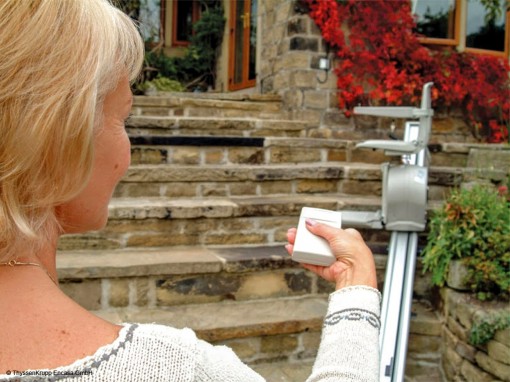 PhotosSource: © ThyssenKrupp AG
PhotosSource: © ThyssenKrupp AGOn these rails, in turn, there are various attachments that characterize the different stairlift models. What they all have in common is that transport is via an electric drive. The steps are thus negotiated with ease. Stair elevators are therefore an important tool to help people with mobility limitations to new independence.
Prices and costs
A stair elevator allows older people to enjoy a new lease on life. The initial cost depends on many different factors, so depending on the equipment and customization, the lift can be significantly cheaper or more expensive than previously thought.
Factors affecting price
The cost of a stair elevator is made up of many different factors. Here it depends, among other things, on which model you choose, which drive is needed and what additional equipment the lift should have.
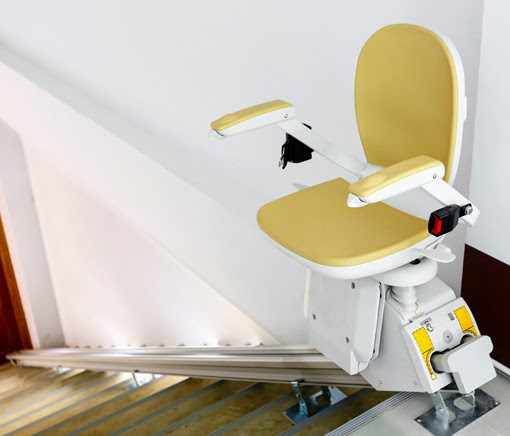 Source: Sukpaiboonwat / Shutterstock
Source: Sukpaiboonwat / ShutterstockFurthermore, the price is also calculated according to the height to be overcome and the load-bearing capacity. In addition, the lift must be adapted to the structural and personal situation of the customer. Basically, therefore, the following applies: a stair elevator is in most cases a custom-made product. So, in summary, the following factors further drive up the overall price:
No. | Cost factors |
|---|---|
| 1. | Complexity and angle of inclination of the stairs |
| 2. | Number of steps |
| 3. | Effort during installation |
| 4. | Height to overcome |
| 5. | Additional equipment and optics |
| 6. | Weather resistance for outdoor installation |
| 7. | Load-bearing capacity and load-bearing capacity |
| 8. | Drive speed |
| 9. | Number of stops |
| 10. | Type of drive (electric motor, traction drive, rack and pinion drive / gear drive) |
The above factors thus ensure that manufacturers generally can not give a blanket price information. At the current time, the average price range for a stair elevator over one floor is around 5,000 to 10,000 €. Used models are already available for less than 3,000 €, but it is important to pay close attention to whether the model is suitable at all. When buying a new stair elevator, a manufacturer can only provide a cost estimate after an on-site inspection. In addition, you should consider in advance whether the stair elevator must also have special or adapted equipment. In this way, the manufacturer can prepare an offer perfectly tailored to your needs.
Acquisition costs
A stair elevator allows barrier-free access often without extensive reconstruction of the living environment. It can be installed within a very short time and is cheaper to purchase than conventional elevators. When buying a stair elevator, you should expect to pay at least 5,000 €. These prices are standard market prices and do not refer to a single manufacturer. In the case of a single-family house with 1 floor and larger conversion costs, prices of up to 10,000 € can quickly arise. If the stair elevator is installed for a wheelchair user, up to 4,000 € subsidy can be applied for and claimed from the care insurance if a corresponding nursing care degree is available.
The price of a stair elevator depends on various factors, e.g. the load capacity, the travel speed, the number of stopping points, the height, the type of drive, the model and the appearance. Stair elevators for outdoor use are understandably more expensive than those for indoor use. The real purchase costs can be determined very accurately by obtaining several cost estimates from different lift manufacturers -and service providers. An incalculable size remains however the costs of the necessary rebuilding measures at the single family house. If larger excavations are necessary at the single-family dwelling, additional costs can develop. Therefore, before buying a stair elevator, find out about “all” the costs involved and financial subsidies. In addition to the care cost subsidy for measures to improve the individual living environment, the state-subsidized KfW Bank promotes measures to reduce barriers with favorable loans of up to 50,000 €.
Lift type | Stair form | Area | Price |
|---|---|---|---|
| Stairlift | straight stairs | Inside | 3,800 to 9,700 € |
| Stairlift | curved stairs | Inside | 8,000 to 15,000 € |
| Stairlift | straight stairs | Outside | 4,000 to 7,500 € |
| Platformlift | straight stairs | Inside | 9,000 to 15,000 € |
| Platformlift | curved stairs | inside | 12,000 to 25,000 € |
| Platformlift | straight stairs | Outside | 9,000 to 15,000 € |
| Platformlift | curved stairs | Outside | 15,000 to 25,000 € |
| Lifting Platform | Height up to 1.79m | Outside | 8,000 to 15,000 € |
| Lifting Platform | Height up to 3m | Exterior | from 17,500 € |
Prices and customization options vary widely from manufacturer to manufacturer. There are no blanket price quotations such as a price per 1 meter height or per stair step. In general, you can say that the more steps it has to climb and the more weight it has to transport, the more expensive it is. For each additional meter, you should expect to pay at least 2,000 € more, not including the cost of conversion work. A stair elevator that is attached to the outside staircase, has a rail length of around 2 meters, has 2 stopping points, moves via a hydraulic drive and can be used by a wheelchair user should cost at least 8,000 € with installation. The purchase is cost-intensive and should be carefully planned. With a price comparison over welcher-Treppenaufzug.de much money can be saved. You will receive up to three free and non-binding offers from stair elevator providers in your region, which you can compare at your leisure and without risk.
Costs for maintenance and servicing
Stair elevators are low-emission, durable, lightweight and space-saving. A stair elevator only needs to have its oil and seals changed every 5 years. The material required for this is freely available and costs around 100 €. For the professional implementation of the oil -and seal change, one should expect costs of about 500 €. The cost of labor for maintenance is about 1,000 €. As a rule, a partial or full maintenance contract is concluded with the elevator manufacturer from whom the stair elevator is purchased to cover maintenance for a period of five or ten years. The costs for maintenance, inspection, cleaning, lubrication, adjustment work and the replacement of wear parts are then usually regulated on a flat-rate basis.
Energy costs
The energy costs for a stair elevator are made up of consumption during travel and standby times. For a stair elevator in a single-family house with 1,500 trips per year, i.e. about 4 trips per day, one should expect energy costs of 200 kWh standby power and 100 kWh travel power. At an electricity price of 0.26 €/kWh, this results in annual costs of approx. 78 €. Platform lifts in single-family homes stand still 99% of the time. The energy costs therefore depend primarily on how much the elevator is used, whether the drive installed is suitable for the particular usage situation and what height the stair elevator has to climb. As a rule, more than 50% of the power consumption of stair elevators is consumed in standby (idle) mode. To save energy costs, you should make sure when buying that LED lamps are installed instead of halogen or incandescent lamps and that a timer function exists for lighting and electronics.
Rent or pay in installments
Many manufacturers also offer the possibility of renting the stair elevator or pay off monthly by installment. Here it is advisable to compare the prices of the different offerers in detail and in peace with one another – that saves cash money. Furthermore, it can’t hurt to talk to your bank advisor about a financing model. In some cases, a bank loan may have lower interest rates than a loan through the respective lift manufacturer. In addition, an on-site inspection and estimate should be non-binding and free of charge.
Where can stair elevators be used?
Stair elevators can be installed on almost any staircase. They can be both straight and curved stairs. The latter, however, make the construction more complex, because the rails of the stair elevators have to follow the exact course of the stairs. As a result, stair elevators for curved staircases usually have to be made to measure. Stair elevators for curved stairs are therefore significantly more expensive than those designed for straight stairs.
The construction of a stair elevator can be designed in such a way that it can be used outdoors without any problems. In this case, attention is then paid to appropriately weather-resistant materials and a construction of the drive designed for outdoor use. Stair elevators can be used to climb smaller staircases as well as to access several floors. The staircase itself remains fully usable. Many stair elevators are equipped with a folding mechanism, so that the stair lift hardly takes up any space when not in use.
Various forms
Probably the most common form of stair elevator is the seat lift. Here, the user takes a seat on a comfortable and safe seat. The transport along the stairs can be controlled by hand (for example, by controls in the armrest or a remote control). An alternative to the seat lift is the standing lift. It comes into question when sitting is only possible with restrictions.
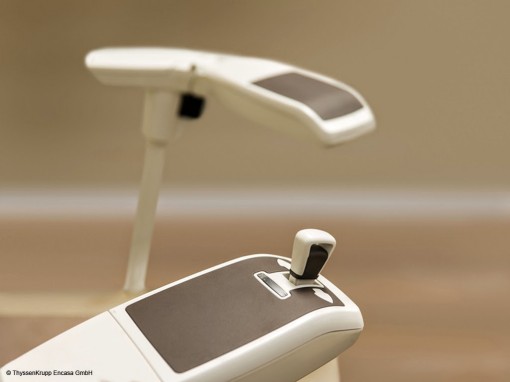 PhotosSource: © ThyssenKrupp AG
PhotosSource: © ThyssenKrupp AGWheelchair users prefer platform lifts. Platform lifts have a spacious platform that is sufficiently sized to transport a wheelchair up the stairs. Platform lifts therefore require a bit more space and are usually more expensive than sit-to-stand lifts. This is also due to the fact that the drive must transport larger loads.
Prices of stair lifts
The prices of stair elevators differ quite significantly. Very simple variants are available from just under 4,000 €. These are usually seat lifts for straight stairs. These usually consist of standard components and are therefore cheap and quickly assembled. However, individual equipment details, such as those relating to the comfort and appearance of the stair elevator, can significantly increase the price. Significantly more expensive are also stair elevators for curved staircases.
The rails usually have to be custom-made or at least individually adapted. A five-figure budget should therefore definitely be planned for curved stairs. Platform lifts for wheelchair users cost up to 10,000 € for straight stairs because they are more complex in design. Models for curved stairs are also significantly more expensive. A surcharge of at least 1,000 € should also be factored in if the stair elevator is to be installed outdoors.
Save costs when buying
A grant for the purchase of a stair elevator can be applied for via the care insurance fund. The maximum subsidy is 4,000 €. One cannot cover the complete purchase price with this, however. Saving costs when buying a stair elevator is therefore important for many interested parties. One way to achieve this is to buy a used stair elevator. Especially with straight staircases this offers itself. There are dealers who specialize in the trade of used stair elevators.
They offer the same service and quality as when buying new, but the costs can be reduced by up to 50 percent. However, the savings potential is significantly lower for curved staircases because the existing rails cannot usually be taken over. If the need is temporary, the rental of a stair elevator may also be an option. Here, too, however, only models for straight staircases are offered in the first instance.

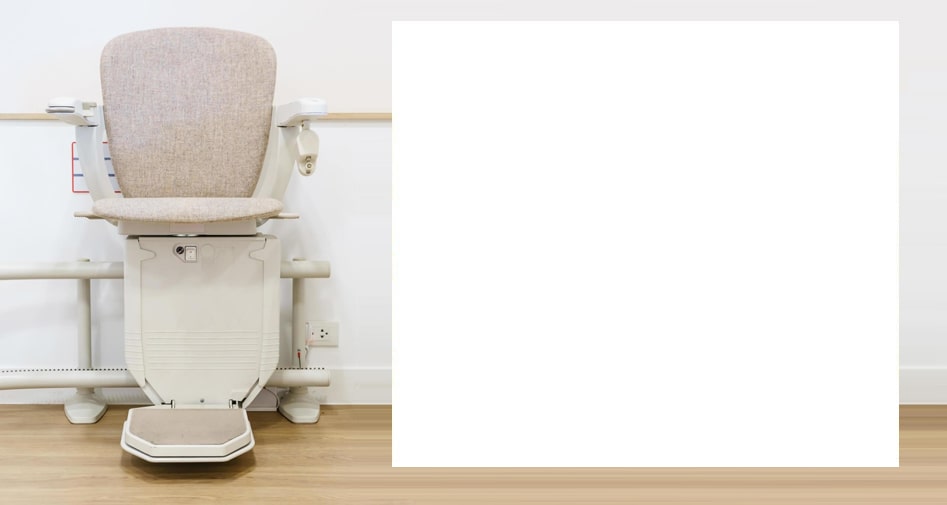
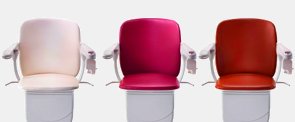
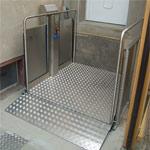
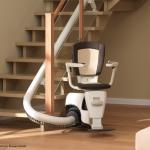
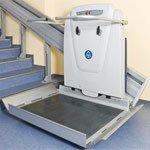
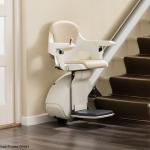
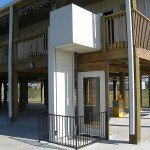
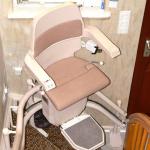
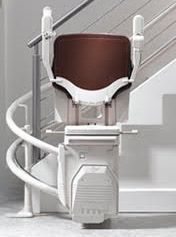
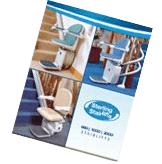
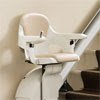
Looking for used inclined stair elevator for installation on a straight staircase, place Düsseldorf. Many thanks and best regards,
Jürgen Schlag
Please send me technical details for a stair lift with a 360° bend for one floor. Mfg, Yafit Nitsan